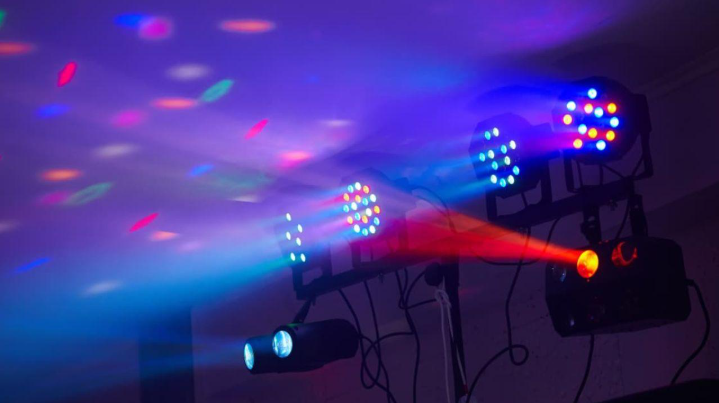GENERAL
DMX and LED Lighting: Understanding Digital Multiplex Control and Its Impact

The DMX system represents one of the most advanced lighting control technologies, and it has become the primary standard for contemporary applications. DMX represents a common term found in LED lighting discussions yet remains unclear to people who lack understanding of its technology definition and operational principles. An led tape light dmx system allows precise control over brightness, color, and effects, making it ideal for dynamic lighting displays. The standardized protocol DMX stands for Digital Multiplex, which controls lighting effects across stage productions, architectural lighting applications, commercial displays, and home automation systems. DMX operates as a crucial modern lighting system component because it allows users to control numerous fixtures simultaneously with both precision and flexible control.

The Origin and Development of DMX
In 1986, USITT established the DMX512 protocol to solve problems that plagued earlier lighting control systems. The adoption of DMX introduced a new era in lighting control systems because analog signals previously used extensive wiring and produced unreliable results. The installation of lighting fixtures became complicated because each fixture required its own specific control line.
DMX introduced a digital communication system enabling controllers to control multiple fixtures through one unified data cable. Standardization of lighting systems through DMX led to simplified setup processes and enhanced reliability along with extended programming potential. The development of DMX technology has extended its original theater-based usage to become an essential control system for numerous industries that need precise lighting management.
How DMX Works in LED Lighting
The digital protocol DMX functions as a communication system that directs controllers to send signals that control lighting fixtures for intensity levels, color selection, and movement patterns. The standard setup for DMX includes a controller unit and DMX-enabled fixtures, which are linked through data cables to exchange instructions. The protocol manages communication through a step-by-step packet system that controls the various functions of connected fixtures.
The standard DMX system works through 512 channels, which enables the control of 512 separate parameters across each universe. Each lighting device receives data from its assigned address within the universe and understands its intended instructions but ignores data meant for other fixtures. The structured design allows designers to build intricate lighting setups because every fixture executes commands exactly as programmed.
LED lighting benefits from DMX control through its ability to provide users with extraordinary control over brightness settings, color temperature adjustments, and dynamic effects operation. The RGB and RGBW LED strips obtain their wide color range, and fluid lighting transitions through DMX signal control. DMX proves most suitable for applications needing automated and coordinated lighting displays because it allows users to synchronize various lights and effects.
Benefits of LED Lighting Systems
The main benefit of using DMX control for LED lighting systems is its ability to deliver exact and customizable control over numerous fixtures. With DMX, users can easily program their lighting sequences and automate transitions between effects because this system eliminates the need for manual adjustments. Stage productions greatly benefit from this advanced control function since it ensures perfect synchronization between lighting effects, musical performances, and stage effects.
DMX implements dimming and scheduling features that improve energy efficiency. The DMX compatibility of LED fixtures enables programmers to set intensity levels that manage power usage while preserving appropriate lighting conditions. The architectural lighting industry uses this capability to program building and monument illumination following specific patterns and event schedules.
DMX provides scalable operations, which is a significant advantage. The DMX protocol enables users to control either small LED fixture collections or extensive venue-wide lighting networks through a system that provides easy integration and growth capabilities. The DMX protocol enables control of numerous lighting parameters through multiple universes, which makes it suitable for large productions, concert events, and commercial installations.

DMX Applications Beyond Entertainment
The entertainment industry created DMX, but today, it serves purposes that exceed live performance illumination. Building facades, bridges, and landmarks get dynamic color-changing effects through architectural lighting designers who employ DMX technology. The implementation of DMX-controlled LED fixtures in urban environments enables cities to generate spectacular nighttime scenes, which simultaneously improve their public areas and attract tourists.
Retail businesses utilize DMX-controlled lighting because adjustable schemes through DMX enable behavior modification among customers while making their displays more noticeable. DMX controls allow stores to set ambiance lighting and create highlight effects that both improve customer shopping experiences and spotlight particular merchandise. DMX controls the lighting systems of restaurants and hotels alongside event venues to help them build distinctive settings that match their brand personality.
Modern residential smart home automation systems now use DMX-compatible LED lights to enable homeowners to customize their lighting environments. The sophistication of residential lighting has increased through DMX technology, which enables users to modify living space illumination and match outdoor lights with music or seasonal elements.
Understanding DMX Addressing and Configuration
Novice users of DMX need to learn how to properly address and configure their lighting fixtures on a DMX network. Every DMX-compatible light needs a starting address to specify the data stream section it will process. The proper planning of addressing becomes essential because fixture types need multiple channels to handle brightness, color, and movement controls while ensuring no address conflicts occur.
Real-time updates of all connected fixtures occur through the continuous data stream from a DMX controller system. Programmers who work with DMX-controlled LED lighting systems benefit from interfaces between software controllers and hardware consoles that enable user modifications and preset storage along with automated sequence control. Applications that need dynamic lighting effects, such as stage shows and multimedia installations, depend heavily on this flexible system.
Conclusion
The Digital Multiplex system (DMX) transformed LED lighting control through its ability to deliver precise control and flexible operation in multiple industries. DMX started its life in theater staging before spreading across architectural spaces and commercial buildings and finally reaching residential areas. The tool provides essential capabilities to manage various fixtures alongside dynamic effect generation and smart lighting integration for designers and lighting professionals. DMX technology will advance alongside technological progress through the implementation of wireless capabilities, IoT integration, and novel lighting effects. DMX-controlled LED lighting stands as a versatile tool for creating mesmerizing visual effects since it can light up stages at concerts or improve building exteriors and retail environments.
GENERAL
Unlocking Potential: Discovering the Role of dados as in Personal Development

Personal development is a journey many embark on, yet few truly understand the power of the tools available to them. It’s not just about setting goals or reading self-help books; it’s about unlocking hidden potential and fostering growth in all aspects of life. One such tool that has gained traction in recent years is dados as, an intriguing concept rooted in history and rich with promise for those willing to explore its depths.
Imagine having a roadmap tailored to your unique strengths and weaknesses—a way to enhance your skills while also nurturing your emotional well-being. The beauty of personal development lies in discovering what works best for you, and dados as offers a refreshing perspective that can transform your approach. Ready to dive deeper? Let’s unravel this fascinating concept together!
The Concept of Dados and its History
Dados, often referred to as “data” in the context of personal development, traces its roots back to ancient practices. The term itself has evolved over time, reflecting changing perceptions of knowledge and information.
Historically, different cultures used various forms of dados—such as storytelling or parables—to pass down wisdom and insights. These narratives served not merely for entertainment but also as tools for reflection and growth.
As societies progressed, so did our understanding of what constitutes valuable data in personal development. Today’s dados encompass a wide range of resources including books, courses, workshops, and even digital content.
The shift from oral traditions to written records marked a pivotal moment in how we engage with knowledge. It laid the groundwork for individuals seeking structured paths toward self-improvement through actionable insights derived from diverse sources.
How Dados can be Used for Personal Development
Dados, often seen as mere tools for games, can unlock a deeper potential in personal development. Their unpredictable nature mirrors life’s uncertainties. Embracing that randomness encourages adaptability.
Use dados to set intentions or goals. Roll them and let the outcome guide your focus for the day or week ahead. This playful approach fosters creativity and helps break through mental blocks.
Incorporate dados into journaling rituals. Each roll can symbolize different themes you explore—self-reflection, gratitude, or aspiration. It adds an element of surprise to your introspection process.
Group activities with dados promote teamwork and communication skills. Sharing interpretations of each roll strengthens connections with others while fostering empathy.
Consider creating challenges based on dado outcomes—small tasks inspired by what they reveal about yourself or your aspirations. This dynamic interaction makes personal growth engaging and memorable.
Tips for Incorporating Dados into Your Own Personal Development Plan
Start by identifying your goals. What areas of personal development resonate most with you? Use dados as a tool to clarify these aspirations.
Next, set measurable milestones. Break your larger objectives into smaller, actionable steps. This way, you can track progress and celebrate achievements along the way.
Incorporate regular reflection sessions into your routine. Reflecting on experiences allows for deeper insights and adjustments in your approach.
Consider integrating dados into journaling practices. Writing about daily challenges or successes can illuminate patterns that need attention.
Seek community support by sharing your journey with others interested in personal growth. Engaging with like-minded individuals can provide new perspectives and encouragement.
Stay flexible in your plan. Life is unpredictable; adapt as necessary while maintaining focus on the core principles of dado practice in achieving personal excellence.
Potential Challenges and How to Overcome Them
When incorporating dados as into your personal development journey, you might encounter various challenges. One common hurdle is the lack of understanding about how to effectively use dados as for self-improvement.
To overcome this, start by educating yourself. Research different methodologies and how others have successfully integrated dados as into their lives. Online courses and community forums can be invaluable resources.
Another challenge is maintaining motivation over time. The novelty may wear off, leading to a decline in enthusiasm. To combat this, create small milestones that celebrate your progress along the way.
Be prepared for setbacks. They are part of any growth process. When faced with obstacles, practice self-compassion and reassess your approach rather than giving up entirely. Adjusting goals or strategies can often reignite your passion for personal development through dados as.
Conclusion:
Personal development is a journey that many embark on in pursuit of self-improvement and fulfillment. The concept of dados as—integral to this journey—offers unique insights into our growth potential. By understanding the historical significance and practical applications of dados, you can unlock new avenues for personal growth.
Incorporating dados into your personal development plan can enhance your self-awareness, decision-making skills, and overall life satisfaction. While challenges may arise along the way, embracing these obstacles as part of the process will empower you to adapt and thrive.
GENERAL
Advantages of Pursuing an Online Master of Science in Nursing (MSN) Program

Flexibility and Convenience
Enrolling in online MSN programs allows working nurses to pursue advanced education while continuing to fulfill professional and personal obligations. With digital access to lectures, assignments, and resources, students can study at their convenience—early mornings, late nights, or weekends—without needing to relocate or commute.
This level of adaptability is crucial for nurses who must balance shift work, family responsibilities, and personal commitments. By breaking barriers to attendance, online MSN options enable more nurses to advance their education and specialize, regardless of their geographic or professional situation.
Cost-Effectiveness
Online MSN programs are often more affordable than their on-campus counterparts. Students enjoy significant savings on commuting, moving, housing, and parking costs. In addition, many programs offer competitive tuition rates that make pursuing an MSN attainable for a broader population of nurses.
Direct and indirect cost reductions alleviate the financial burden on working professionals, allowing them to invest in their education without sacrificing financial stability. According to U.S. News & World Report, online graduate programs frequently offer in-state tuition rates to distance learners, further enhancing affordability.
Access to Diverse Perspectives
The virtual nature of online MSN education draws students from regions across the country and even internationally. This geographic diversity fosters dynamic online discussions and project collaborations, enhancing peer-to-peer learning. Exposure to a diverse student body encourages nurses to learn about differing healthcare environments, policies, and patient care approaches, broadening their worldview and cultural competence.
Research published in the Journal of Nursing Education has shown that exposure to diverse practice models and cultural viewpoints during graduate nursing education strengthens future nursing leadership and adaptability.
Career Advancement Opportunities
One of the most compelling benefits of earning an online MSN is access to advanced practice roles, such as Nurse Practitioner, Clinical Nurse Specialist, Nurse Educator, and healthcare administrator. These positions command higher salaries, a broader scope of practice, and greater job security. The U.S. Bureau of Labor Statistics lists a median annual salary of $121,610 for nurse practitioners and expects a 38% job growth from 2022 to 2032—much faster than the average for all occupations.
Graduates are prepared to lead teams, make evidence-based decisions, and directly influence patient outcomes on an organizational scale. For nurses desiring to climb the clinical or administrative ladder, an MSN opens doors that would otherwise remain closed.
Development of Leadership and Management Skills
Online MSN curricula are designed to cultivate essential leadership, administrative, and policy-making skills. Courses in health systems leadership, organizational behavior, and nursing management train students to supervise teams, design care models, and participate in holistic change management. These skills position MSN-prepared nurses as future leaders ready to drive improvements across the healthcare continuum.
The American Association of Colleges of Nursing underscores the value of advanced education in developing nurse leaders capable of adapting to the increasingly complex healthcare system and advocating for patient-centered care.
Technological Proficiency
Online MSN education naturally improves digital fluency and technical competence. Students gain comfort with learning management systems, virtual simulations, telehealth platforms, and digital record-keeping—skills vital for today’s healthcare landscape. As medicine integrates new technologies, nurses adept in these areas provide immense value to their employers and patients.
According to an article in Healthcare IT News, digital literacy among nurses is linked to better clinical practice and improved patient safety, demonstrating an additional benefit of online graduate studies.
Accreditation and Credibility
Many reputable online MSN programs are accredited by respected bodies such as the Commission on Collegiate Nursing Education (CCNE) and the Accreditation Commission for Education in Nursing (ACEN). Accreditation ensures adherence to national standards, validating the program’s quality and the graduate’s credentials. A degree from an accredited program assures potential employers of a nurse’s readiness for advanced roles and lifelong learning.
Accreditation status can be verified through the U.S. Department of Education or the respective nursing commissions.
Preparation for Doctoral Studies
Completing an online MSN prepares nurses for further academic achievement, such as pursuing a Doctor of Nursing Practice (DNP) or a Ph.D. in Nursing. The advanced critical thinking, research, and clinical skills gained during MSN studies lay the foundation for success in any doctoral nursing program. Many online MSN graduates go on to shape health policy, lead large healthcare organizations, or enter academia.
Conclusion
Earning an online MSN program offers numerous advantages, including flexibility, affordability, and opportunities to engage with diverse global nursing perspectives while strengthening technological expertise. For nurses striving to advance their careers and make a greater impact in healthcare, programs such as those available through Arkansas State University provide pathways that align with the evolving demands of the profession and its future challenges.
GENERAL
Unveiling lwedninja: The Ultimate Guide to Mastering Your Online Presence

In today’s digital landscape, mastering your online presence is more crucial than ever. Enter lwedninja, a powerful tool designed to elevate your personal branding and help you stand out in the crowded online space. Whether you’re an aspiring influencer, a small business owner, or simply someone looking to make their mark on social media, lwedninja offers the strategies and insights needed to succeed.
Gone are the days of blending into the background. With lwedninja by your side, you can take control of how you’re perceived online. Imagine curating a persona that resonates with your audience while showcasing your unique talents and passions. The journey starts here as we explore the essential components you’ll need to build an impressive online identity using lwedninja’s innovative approach. Buckle up; it’s time to transform how others see you!
The Power of Personal Branding
Personal branding is more than just a buzzword; it’s your digital fingerprint. It reflects who you are, what you stand for, and how others perceive you online.
With lwedninja at your side, harnessing the power of personal branding becomes effortless. Your unique story deserves to be told effectively across various platforms.
When people resonate with your brand, trust builds. Trust leads to opportunities—collaborations, partnerships, and even job offers can stem from a well-crafted personal image.
Engaging visuals combined with authentic messaging create a strong foundation for connection. It’s not about being perfect; it’s about being genuine.
Take time to define your values and mission. A clear personal brand attracts like-minded individuals and fosters meaningful relationships in both personal and professional spheres.
Building Your Online Presence with lwedninja
Building your online presence with lwedninja starts with understanding who you are and what makes you unique. This platform empowers you to craft a personal brand that resonates.
Create a strong profile that highlights your skills, interests, and values. Use eye-catching visuals and authentic storytelling to draw people in. Your online persona should reflect the real you.
Engage consistently across various platforms. lwedninja encourages interaction; don’t shy away from connecting with others in your niche. Comment on posts, share insights, and build relationships that matter.
Optimize your content for discoverability using relevant keywords related to your field while also embracing creativity. Tailor each message for different audiences—this personalization can widen your reach significantly.
Remember, it’s not just about posting; it’s about creating an engaging experience for those who encounter your content on lwedninja.
Utilizing Social Media Platforms for Maximum Impact
Social media is a powerful tool for amplifying your online presence. Each platform offers unique features that can elevate your brand.
Instagram thrives on visuals, making it perfect for showcasing products or services. High-quality images and engaging stories can draw in followers who appreciate aesthetics.
Twitter, on the other hand, allows you to share quick thoughts and connect with real-time conversations. Use hashtags wisely to increase visibility and attract like-minded individuals.
LinkedIn stands out as a professional networking site. It’s ideal for sharing industry insights and establishing authority in your field. Engaging with others’ content further enhances your credibility.
Facebook remains popular for building communities around shared interests. Create groups or pages where people can interact and exchange ideas seamlessly.
Adapting your approach based on each platform’s strengths will help you maximize impact across social channels without losing authenticity.
Creating Engaging Content and Fostering Connections
Creating engaging content is the heartbeat of any successful online presence. It draws people in and keeps them coming back for more. Think about storytelling—everyone loves a good story. Share your journey, experiences, and insights to create emotional connections.
Visuals play a crucial role too. High-quality images or videos can captivate your audience instantly. People are more likely to share visually appealing content with their networks.
Don’t forget interaction! Encourage comments and respond promptly. This fosters a sense of community around your brand. Ask questions that spark discussions or invite followers to share their own stories.
Utilizing polls or quizzes also enhances engagement levels while making your audience feel involved in the conversation. These tactics not only make your content lively but also help build lasting relationships with your followers, creating an interactive space where everyone feels valued.
Measuring Your Success with Analytics
Understanding your progress is vital in the digital landscape. That’s where analytics come into play. They provide insights that help you gauge your online performance.
Start by setting clear goals. What do you want to achieve? Increased followers, more website visits, or higher engagement rates? Once defined, use tools like Google Analytics and social media insights to track these metrics.
Look at key performance indicators (KPIs). Metrics such as bounce rate, session duration, and conversion rates tell a story about user interaction on your platforms.
Don’t just collect data—analyze it. Identify trends over time and see what works for you. Maybe certain content types resonate better with audiences or specific times yield higher engagement.
Adjust strategies based on findings. Flexibility is crucial in the fast-paced world of online branding. By continuously measuring success through analytics, you’ll enhance your approach and build a stronger presence online.
Conclusion:
Mastering your online presence is essential in today’s digital landscape. lwedninja equips you with the tools and strategies needed to elevate your personal brand. By harnessing the power of social media, creating engaging content, and analyzing your efforts, you can cultivate a strong online identity that resonates with your audience.
The journey towards becoming an online authority may seem daunting, but with lwedninja by your side, you’re well on your way to standing out. Embrace the process and watch as opportunities unfold before you. Your path to success starts now; take action and let lwedninja guide you every step of the way.
-

 GENERAL2 years ago
GENERAL2 years agoDiscovering the Artistic Brilliance of Derpixon: A Deep Dive into their Animation and Illustration
-

 Posts2 years ago
Posts2 years agoSiegel, Cooper & Co.
-

 Lifestyle2 years ago
Lifestyle2 years agoPurenudism.com: Unveiling the Beauty of Naturist Lifestyle
-

 FASHION2 years ago
FASHION2 years agoThe Many Faces of “λιβαισ”: A Comprehensive Guide to its Symbolism in Different Cultures
-

 HEALTH2 years ago
HEALTH2 years agoTransformative Health Solutions: Unveiling the Breakthroughs of 10x Health
-

 Lifestyle2 years ago
Lifestyle2 years agoBaddieHub: Unleashing Confidence and Style in the Ultimate Gathering Spot for the Baddie Lifestyle
-

 Entertainment2 years ago
Entertainment2 years agoGeekzilla Podcast: Navigating the World of Pop Culture, Gaming, and Tech
-

 Lifestyle1 year ago
Lifestyle1 year agoSandra orlow: Unraveling the Story of an Iconic Figure
